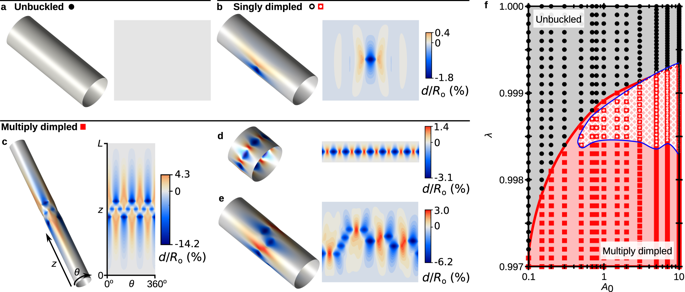Communications Physics ( IF 5.4 ) Pub Date : 2019-11-29 , DOI: 10.1038/s42005-019-0251-4 J. R. Panter , J. Chen , T. Zhang , H. Kusumaatmaja

|
Even for relatively simple thin shell morphologies, many different buckled configurations can be stable simultaneously. Which state is observed in practice is highly sensitive to both environmental perturbations and shell imperfections. The complexity and unpredictability of postbuckling responses has therefore raised great challenges to emerging technologies exploiting buckling transitions. Here we show how the buckling landscapes can be explored through a comprehensive survey of the stable states and the transition mechanisms between them, which we demonstrate for cylindrical shells. This is achieved by combining a simple and versatile triangulated lattice model with efficient high-dimensional free-energy minimisation and transition path finding algorithms. We then introduce the method of landscape biasing to show how the landscapes can be exploited to exert control over the postbuckling response, and develop structures which are resistant to lateral perturbations. These methods now offer the potential for studying complex buckling phenomena on a range of elastic shells.
中文翻译:

利用能源景观探索来控制圆柱壳的屈曲
即使对于相对简单的薄壳形态,许多不同的带扣配置也可以同时稳定。在实践中观察到哪种状态对环境扰动和外壳缺陷都高度敏感。因此,屈曲后响应的复杂性和不可预测性对利用屈曲过渡的新兴技术提出了巨大挑战。在这里,我们展示了如何通过对稳定状态及其之间的过渡机制的全面调查来探索屈曲景观,我们对圆柱壳进行了演示。这是通过将简单而通用的三角晶格模型与高效的高维自由能最小化和过渡路径查找算法相结合来实现的。然后,我们介绍了景观偏向的方法,以展示如何利用景观来控制屈曲后的响应,并开发出能够抵抗横向扰动的结构。这些方法现在为研究一系列弹性壳上的复杂屈曲现象提供了潜力。

































 京公网安备 11010802027423号
京公网安备 11010802027423号